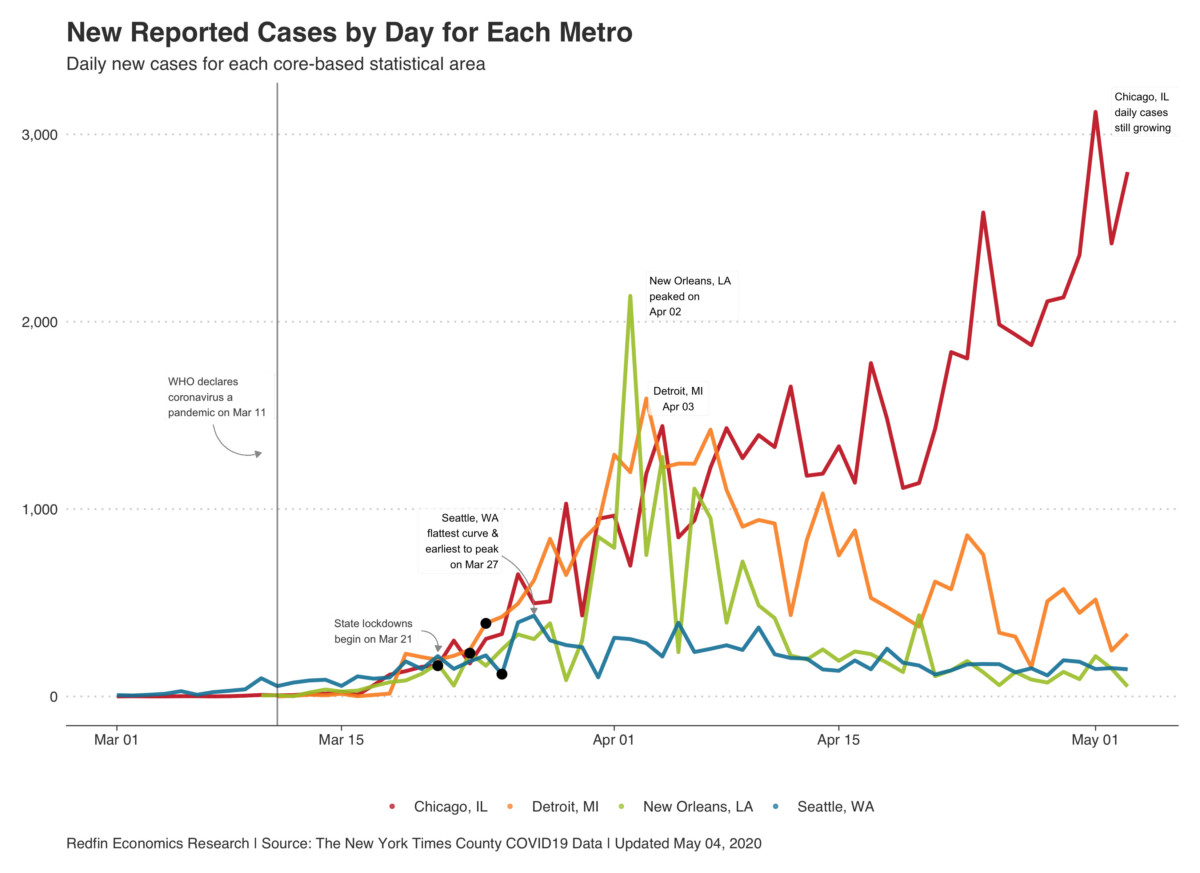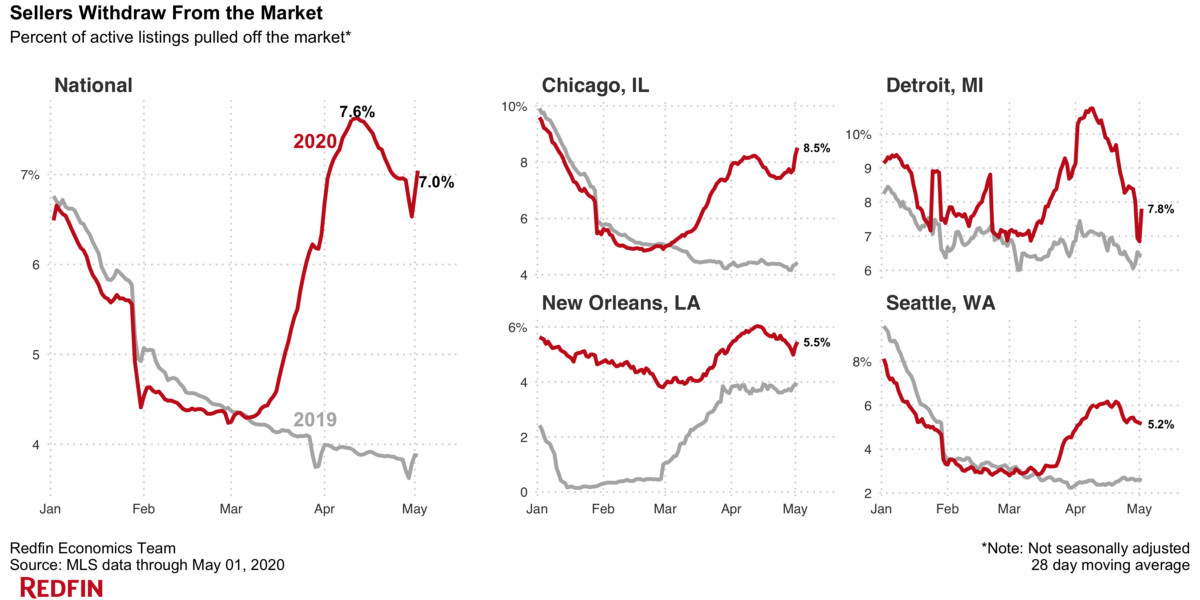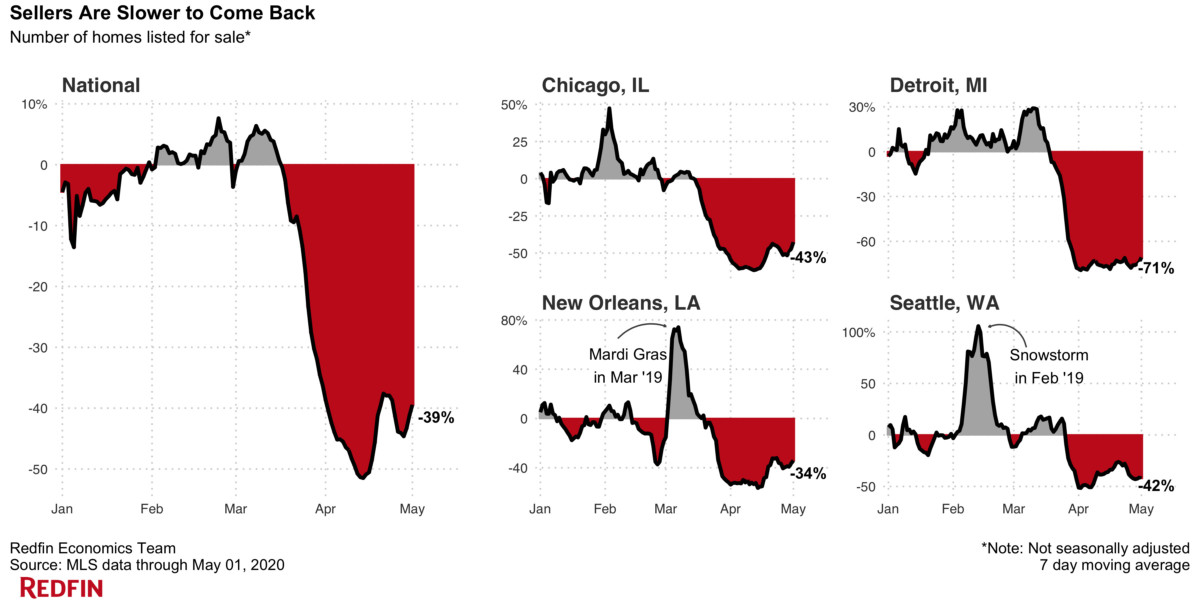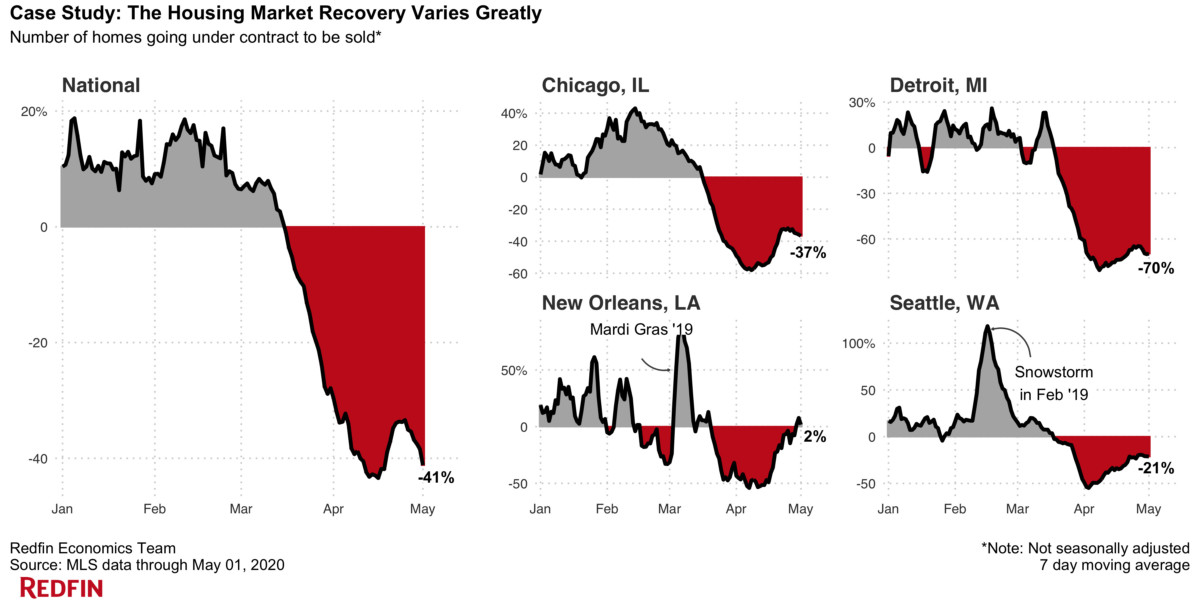The WPJ
THE WORLD PROPERTY JOURNALReal Estate Facts Not Fiction
Residential Real Estate News

Where COVID-19 Has Not Peaked, U.S. Housing Markets Show Signs of Recovery
Residential News » Seattle Edition | By WPJ Staff | May 11, 2020 8:00 AM ET
Property broker Redfin is reporting this week that new listings and home sales are seeing early signs of recovery in the U.S. housing market, even as some cities struggle to flatten the coronavirus curve.
It found that in areas where real estate has been deemed an essential service, both housing supply and demand is beginning to strengthen, even if the community has not yet experienced a peak in COVID-19 cases.
A Tale of Four Metros
Redfin examined delistings, new listings and home sales in Chicago, where COVID-19 continues to trend upward; Seattle and New Orleans, which have flattened the curve; and Detroit, which has also flattened the curve but did not deem real estate essential.
A Rollercoaster of Homes Taken Off Market
A surge in home delistings was one of the first signs that the housing market was experiencing a coronavirus-driven downturn. Nationally, delistings hit a record during the 28-day period ending April 9, when nearly 75,000 homes (1 of every 13 houses for sale) were pulled off the market. That compares with just 47,000 during the same period in 2019. Delistings have since slowed in most markets, but are still far more common than they were at this time last year.
Detroit experienced the earliest and sharpest rise and fall in delistings. More than 600 homes, or about 1 in 9 houses for sale, were pulled off the market during the 28-day period ending April 5. That number had fallen to 380 homes, or about 1 in 13 listings, as of May 1st.
In Chicago last month it appeared that the share of homes being delisted was starting to decline, however it has since bounced back and surpassed its prior peak. More than 2,600 homes, or 8.5% of active listings, were removed from the market during the 28-day period ending May 1. That's up from less than 8% a month prior.
Meanwhile, delistings in both New Orleans and Seattle peaked at around 6% of active listings in mid-April, and have since retreated to around 5%.
Home Listings Tank--Then Trickle Back in Most Markets
Nationally, new listings bottomed the week ending April 14 at about 48,000 homes--half the amount during the same period last year. They've since started to rebound in most markets, climbing to around 62,000 homes nationally during the week ending May 1, 2020.
In Seattle, new listings began to crash due to the coronavirus toward the end of March, when the stay-at-home order began and daily new COVID-19 cases hit an all-time high. They bottomed at the start of April, down 52% from the same period the prior year, and have since pared some losses, now only down around 42%. New listings in New Orleans reacted similarly, but took slightly longer to rebound, not staging a comeback until mid-April.
Detroit saw the biggest collapse in new listings, sinking as much as 79% from the prior year during the week ending April 2. Unlike the other metros in our analysis, new listings in Detroit have yet to rebound significantly, still down 70%, as real estate remains a non-essential service. New listings in Chicago are now only down 43% following a plunge of as much as 61% in April, despite continued growth in new daily COVID-19 cases.
Sales Sink, Then Rebound
As supply collapsed in April, so did demand--although it has seen a relatively quick comeback in some markets. The number of homes under contract to be sold plummeted nationally by 43% to about 32,000 during the week ending April 16, as buyers backed away from the market amid skyrocketing unemployment. Sales have since started to recover.
New Orleans has experienced the sharpest rebound, mirroring its encounter with COVID-19. With new coronavirus cases lower than any of the other three metros, pending sales in New Orleans are now up 2% year-over-year. That follows a record 54% plunge during the first week of April--the same week the metro saw COVID-19 cases peak. The Seattle metro has also seen a stark comeback, with pending sales now down just 21% following a 55% decline in early April.
Despite the continued rise in COVID-19 cases, demand in Chicago has also shown resilience--albeit not as much as in Seattle or New Orleans. Pending sales are now down just 37%, an improvement from the 58% decline in April.
Of the four metros in our analysis, Detroit has seen the weakest rebound, with homes under contract now down 70% after bottoming at about 80%. Still, people are buying move-in ready houses at lower price points, according to local agent Tony Orlando.
"Homes going for $250,000 and under are still super competitive," Orlando said. "One of my clients toured a $215,000 house in Pontiac, MI on a group Zoom call with several other prospective buyers the day it hit the market. Within 30 minutes, there were four offers. The property went for above-asking during a pandemic."
It found that in areas where real estate has been deemed an essential service, both housing supply and demand is beginning to strengthen, even if the community has not yet experienced a peak in COVID-19 cases.
A Tale of Four Metros
Redfin examined delistings, new listings and home sales in Chicago, where COVID-19 continues to trend upward; Seattle and New Orleans, which have flattened the curve; and Detroit, which has also flattened the curve but did not deem real estate essential.
- Chicago: The metro area hasn't yet experienced a peak in COVID-19 cases. There were still nearly 3,000 new cases a day as of May 4. Despite this, both housing supply and demand are strengthening here.
- Detroit: The only metro in our analysis where real estate was not deemed an essential service--meaning agents are unable to show homes and visit with clients while the state's stay-at-home order is in place--Detroit flattened the curve in early April. Michigan announced last week restrictions on real estate would ease beginning on May 7. Of the four metros in our analysis, it is experiencing the weakest housing market rebound, despite having flattened the curve.
- New Orleans: The area experienced a relatively dramatic rise--and subsequent fall--in coronavirus cases, surpassing 2,000 daily new cases on April 2 and then quickly falling to below 500 about a week later. Both housing supply and demand are strengthening here.
- Seattle: The first reported epicenter of the U.S. coronavirus outbreak, it was also the first metro in our analysis to flatten the curve--in late March--thanks to early social distancing and testing. Both housing supply and demand are strengthening here.
A Rollercoaster of Homes Taken Off Market
A surge in home delistings was one of the first signs that the housing market was experiencing a coronavirus-driven downturn. Nationally, delistings hit a record during the 28-day period ending April 9, when nearly 75,000 homes (1 of every 13 houses for sale) were pulled off the market. That compares with just 47,000 during the same period in 2019. Delistings have since slowed in most markets, but are still far more common than they were at this time last year.
Detroit experienced the earliest and sharpest rise and fall in delistings. More than 600 homes, or about 1 in 9 houses for sale, were pulled off the market during the 28-day period ending April 5. That number had fallen to 380 homes, or about 1 in 13 listings, as of May 1st.
In Chicago last month it appeared that the share of homes being delisted was starting to decline, however it has since bounced back and surpassed its prior peak. More than 2,600 homes, or 8.5% of active listings, were removed from the market during the 28-day period ending May 1. That's up from less than 8% a month prior.
Meanwhile, delistings in both New Orleans and Seattle peaked at around 6% of active listings in mid-April, and have since retreated to around 5%.
Home Listings Tank--Then Trickle Back in Most Markets
Nationally, new listings bottomed the week ending April 14 at about 48,000 homes--half the amount during the same period last year. They've since started to rebound in most markets, climbing to around 62,000 homes nationally during the week ending May 1, 2020.
In Seattle, new listings began to crash due to the coronavirus toward the end of March, when the stay-at-home order began and daily new COVID-19 cases hit an all-time high. They bottomed at the start of April, down 52% from the same period the prior year, and have since pared some losses, now only down around 42%. New listings in New Orleans reacted similarly, but took slightly longer to rebound, not staging a comeback until mid-April.
Detroit saw the biggest collapse in new listings, sinking as much as 79% from the prior year during the week ending April 2. Unlike the other metros in our analysis, new listings in Detroit have yet to rebound significantly, still down 70%, as real estate remains a non-essential service. New listings in Chicago are now only down 43% following a plunge of as much as 61% in April, despite continued growth in new daily COVID-19 cases.
Sales Sink, Then Rebound
As supply collapsed in April, so did demand--although it has seen a relatively quick comeback in some markets. The number of homes under contract to be sold plummeted nationally by 43% to about 32,000 during the week ending April 16, as buyers backed away from the market amid skyrocketing unemployment. Sales have since started to recover.
New Orleans has experienced the sharpest rebound, mirroring its encounter with COVID-19. With new coronavirus cases lower than any of the other three metros, pending sales in New Orleans are now up 2% year-over-year. That follows a record 54% plunge during the first week of April--the same week the metro saw COVID-19 cases peak. The Seattle metro has also seen a stark comeback, with pending sales now down just 21% following a 55% decline in early April.
Despite the continued rise in COVID-19 cases, demand in Chicago has also shown resilience--albeit not as much as in Seattle or New Orleans. Pending sales are now down just 37%, an improvement from the 58% decline in April.
Of the four metros in our analysis, Detroit has seen the weakest rebound, with homes under contract now down 70% after bottoming at about 80%. Still, people are buying move-in ready houses at lower price points, according to local agent Tony Orlando.
"Homes going for $250,000 and under are still super competitive," Orlando said. "One of my clients toured a $215,000 house in Pontiac, MI on a group Zoom call with several other prospective buyers the day it hit the market. Within 30 minutes, there were four offers. The property went for above-asking during a pandemic."
Sign Up Free | The WPJ Weekly Newsletter
Relevant real estate news.
Actionable market intelligence.
Right to your inbox every week.
Real Estate Listings Showcase
Related News Stories
Residential Real Estate Headlines
- More Americans Opting for Renting Over Homeownership in 2024
- BLOCKTITLE Global Property Tokenization Platform Announced
- Small Investors Quietly Reshaping the U.S. Housing Market in Late 2024
- Greater Miami Overall Residential Sales Dip 9 Percent in November
- U.S. Home Sales Enjoy Largest Annual Increase in 3 Years Post Presidential Election
- U.S. Housing Industry Reacts to the Federal Reserve's Late 2024 Rate Cut
- U.S. Home Builders Express Optimism for 2025
- Older Americans More Likely to Buy Disaster-Prone Homes
- NAR's 10 Top U.S. Housing Markets for 2025 Revealed
- U.S. Mortgage Delinquencies Continue to Rise in September
- U.S. Mortgage Rates Tick Down in Early December
- Post Trump Election, U.S. Homebuyer Sentiment Hits 3-Year High in November
- Global Listings Aims to Become the Future 'Amazon of Real Estate' Shopping Platform
- Greater Las Vegas Home Sales Jump 15 Percent in November
- Ultra Luxury Home Sales Globally Experience Slowdown in Q3
- World Property Exchange Announces Development Plan
- Hong Kong Housing Market to Reach Equilibrium in Late 2025
- Construction Job Openings in U.S. Down 40 Percent Annually in October
- U.S. Mortgage Applications Increase in Late October
- World Property Markets, World Property Media to Commence Industry Joint-Venture Funding Rounds in 2025
- New Home Sales Hit 2 Year Low in America
- U.S. Pending Home Sales Increase for Third Consecutive Month in October
- Pandemic-led Residential Rent Boom is Now Fizzling in the U.S.
- Emerging Global Real Estate Streamer WPC TV Expands Video Programming Lineup
- 1 in 5 Renters in America Entire Paycheck Used to Pay Monthly Rent in 2024
- U.S. Home Sales Jump 3.4 Percent in October
- Home Buyers Negotiation Power Grows Amid Cooling U.S. Market
- Canadian Home Sales Surge in October, Reaching a Two-Year High
- Greater Orlando Area Home Sales Continue to Slide in October
- U.S. Mortgage Credit Availability Increased in October
- U.S. Mortgage Rates Remain Stubbornly High Post Election, Rate Cuts
- Construction Input Prices Continue to Rise in October
- BETTER MLS: A New Agent and Broker Owned National Listings Platform Announced
- Home Prices Rise in 87 Percent of U.S. Metros in Q3
- Caribbean Islands Enjoying a New Era of Luxury Property Developments
- The World's First 'Global Listings Service' Announced
- Agent Commission Rates Continue to Slip Post NAR Settlement
- Market Share of First Time Home Buyers Hit Historic Low in U.S.
- Greater Palm Beach Area Residential Sales Drop 20 Percent Annually in September
- Mortgage Applications in U.S. Dip in Late October
Reader Poll
Marketplace Links
This website uses cookies to improve user experience. By using our website you consent in accordance with our Cookie Policy. Read More









